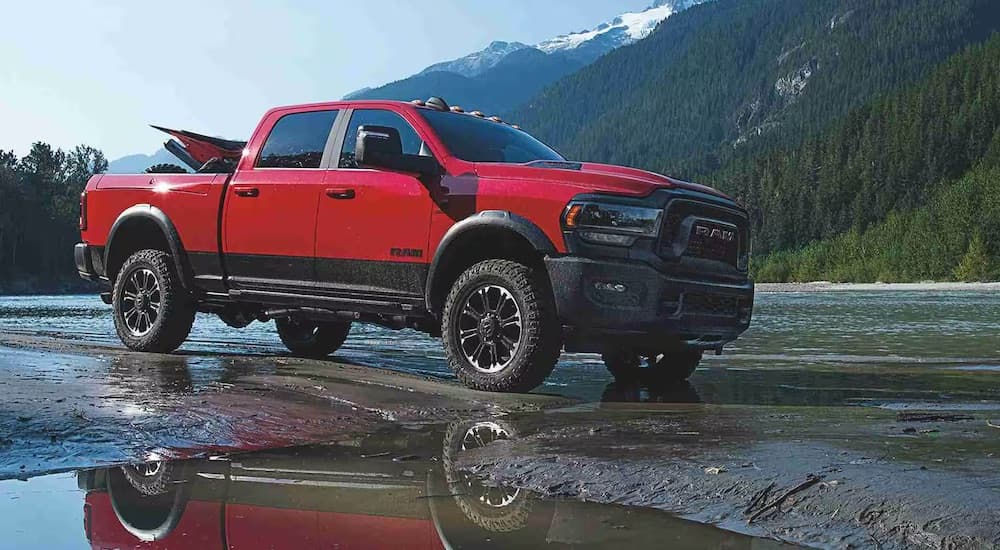Facing a prolonged sales slump, the world’s fourth-largest automaker could soon start making some drastic cuts to its portfolio of brands. Stellantis was formed in 2021 when Fiat Chrysler Automobiles merged with France’s Groupe PSA. While it was hoped the merger would result in considerable cost savings, drive global expansion, and enhance each brand’s own strengths, the automotive behemoth has struggled in the years since.
The slide has been particularly noticeable over the last year, with net profits dropping by almost 50 percent just six months into 2024. This has been reflected in Stellantis’ stock price, with STLA losing 33 percent of its value between January 1 and early September. Stellantis’ woes aren’t entirely unique, as supply chain uncertainty and the slow growth of the EV segment have affected every automaker, but the company’s CEO is ready to take some drastic measures to right the ship. “If they don’t make money, we’ll shut them down,” Stellantis CEO Carlos Tavares said during a conference in late July. “We cannot afford to have brands that do not make money.”
Giving the ax to underperforming brands is nothing new in the auto industry. Mercury, Oldsmobile, Saab, and Saturn have all gone the way of the dodo over the last couple of decades as companies like Ford and General Motors retooled their portfolios for a changing market, but Stellantis’ issue is exacerbated by its sheer size. As recent economic history has taught us time and time again, “too big to fail” isn’t really a thing. With 14 brands under its umbrella, including Dodge, Jeep, Ram, Fiat, Chrysler, Maserati, Alfa Romeo and Peugeot, Citroen, Opel, and Vauxhall, no other company can touch Stellantis in terms of sheer scope. That diversity can pay dividends in a strong market by driving sales in various automobile niches, but it can also become a real liability when things get tough.

Survival of The Fittest
Things are now decidedly tough, and it’s hard to see all 14 Stellantis brands surviving the coming storm. Which brands are destined for the chopping block, and which are strong enough to survive? That’s a question that’s likely being debated at the highest echelons of Stellantis management, but a quick analysis of some recent sales trends and larger market conditions offers an interesting look into how it’ll all shake out. We’re going to focus on the Stellantis brands that can currently be found in the US market, though Peugeot, Citroen, Opel, and other global brands will certainly also factor in the conglomerate’s plans going forward.
Ram
Realistically speaking, a few Stellantis brands are reasonably safe, though there have been some troubling trends as of late. Given America’s insatiable appetite for all things pickup, Ram is likely here for the long haul. The Ram 1500 ranks as one of the industry’s most popular full-size trucks, routinely trading second place with the Chevy Silverado and maintaining a solid volume of around 500,000 units per year, doubling the GMC Sierra’s fourth-place sales. That said, the iconic truck brand did see an alarming 26-percent drop in sales for Q2 of 2024. That sort of drop-off will cause some sleepless nights at Stellantis HQ, though execs are hoping that an ambitious mid-cycle refresh for 2025 might lead to a nice little bump in sales.
Jeep
Jeep has also experienced a year-over-year sales decline of 19 percent, largely due to the discontinuation of the Cherokee and Renegade models. The Wrangler, Gladiator, and Grand Cherokee were also down between 17 and 26 percent. Still, it’s hard to see Stellantis pulling the plug on Jeep anytime soon. In addition to its extensive history, Jeep enjoys a unique consumer-driven culture that few other brands can match. The luxury-focused Wagoneer and Grand Wagoneer have both been hot tickets in 2024, with sales increasing by 24 and 107 percent, respectively. While sales have been slow lately, the Gladiator allows Jeep to compete in the profitable pickup segment. In addition to this encouraging trend, Jeep easily ranks as the best-selling Stellantis brand in the US market and second globally behind Fiat, while Ram is a not-so-close second and fifth globally.
Dodge
The fate of some of the other brands is a little less certain, especially when it comes to the third-best-selling US marquee of Dodge. When the performance-focused legacy brand skipped out of 2024 for its iconic Charger and Challenger muscle cars, longtime Dodge fans feared the worst. But the rumors of the muscle cars’ deaths were greatly exaggerated, at least in the case of the Charger. Dodge announced the muscle car will return for the 2025 model year as both an EV and a gas-powered model that bears a new twin-turbocharged 3.0L Hurricane engine, though the Challenger will share no such reprieve. The American market will always be thirsty for a muscle car, and while Dodge seems relatively safe at the moment, there’s no telling if that enthusiasm will extend to the new generation of all-electric models.
Chrysler
The Chrysler brand will mark 100 years in the business in 2025 if it can stick around that long. Once a mainstay of the American automotive market, Chrysler has fallen on hard times and seen its lineup reduced to a single model, the Pacifica minivan. The minivan market is not exactly a profitable niche in the modern-day market, thanks to the growing popularity of the crossover SUV. With better, more reliable models offered in the Honda Odyssey and Toyota Sienna, it’s hard to see a future for Chrysler. The company did tease a Halcyon concept car that would represent the start of the company’s all-electric future, but with EVs losing ground to hybrids and gas-powered cars still representing the vast majority of the market, we’d be willing to bet that the Halcyon will never see its day. Guidehouse Insights auto analyst Sam Abuelsamid seems to agree, tagging Chrysler as “number one among North American brands” in terms of the likelihood of discontinuation.
Fiat
While there was some initial enthusiasm when Fiat returned to the US market in 2011, sales have steadily declined since 2015. 2022 represented a particularly low point with a year-over-year decline of 61 percent, and 2023 wasn’t too much better at a 34 percent decline. Even more alarming is the number of units being moved. According to data compiled by Good Car Bad Car, Fiat sold just 602 vehicles in 2023. Things aren’t much better in the European market following five years of falling sales and an astronomical year-over-year decline of 59 percent between 2021 and 2022. Fiat’s presence on the US market is currently limited to just two models, the all-electric 500e and the gas-powered 500x subcompact crossover, which is basically a Jeep Renegade with some Italian-inspired touches. Given the general slowdown in EV sales, Fiat won’t have an easy road ahead, with the 500e encompassing half the lineup. If cuts are indeed coming, killing off Fiat’s US presence would be pretty easy to justify, though the brand still moves around 220,000 units a year in Europe.
Maserati
As a performance-focused sports car brand, Maserati plays by different rules than the rest of the Stellantis stable. The GranTurismo, GranCabrio, and MC20 are the kind of finely tuned speed machines that Maserati is known for, but the brand has also done a good job of diversifying its lineup to meet the demands of a SUV-obsessed US market with models like the Grecale and Levante crossover and the Ghibli and Quattroporte SUVs. The Italian-born brand is also diving into the EV market with the Folgore, which should be a little more immune to the segment’s slowdown thanks to the performance potential unlocked by an all-electric powertrain. Maserati’s sales have been on the upswing in the last few years, rising from 16,900 units in 2020 to 26,700 in 2023.
Profits are another story, however, with the brand logging a $89 million loss over the first two quarters of 2024. It’s a confusing trend, to be sure, but it likely won’t factor too heavily into Maserati’s future. Stellantis simply needs a high-performance brand in its portfolio, and Maserati is the best that it has. Some pundits predict that Stellantis could spin Maserati off into its own brand as Fiat-Chrysler did with Ferrari in 2014, but regardless of how the reorganization shakes out, expect to see Maseratis hitting 185 across US roads for years to come.
Alfa Romeo
Things are slowly trending in a positive direction for Alfa Romeo, thanks in large part to the newly introduced Tonale. Basically Alfa’s version of the Dodge Hornet, the Tonale crossover is joined by the Giulia sedan and Stelvio crossover, as well as high-performance Quadrifoglio versions of the latter two. The Tonale helped Alfa Romeo record an eight percent sales bump in Q2, offsetting Giulia and Stelvio’s slumping at -24 and -29 percent. Alfa Romeo logged its most successful year on the US market in 2018 when it sold 23,800 units, but that number has since dropped to just under 11,000 for 2023. These three Alfa Romeo models are all currently gas-powered, though electrification could play a larger part in the company’s future, at least according to former Fiat Chrysler Automobiles (FCA) CEO Sergio Marchionne. Only time will tell if Tavares shares Marchionne’s vision, though as we’ve discussed, EVs are becoming a harder sell by the day.
Other Brands
We’ve largely focused on Stellantis’ North American portfolio, but some of the biggest and most obvious cuts could come on the other side of the pond. Lancia has consolidated its territory solely to Italy, while DS, an offshoot of Citroen created in 2015, has largely failed to capture the premium market it was aimed at. Oddly, Stellantis has also reportedly weighed bringing the DS brand to America, but it now seems rather unlikely given the current cuts. Other European stalwarts like Peugeot, Opel, and, to a lesser extent, Vauxhall all seem relatively safe, though rebranding Britain’s Vauxhall as Opel is not out of the question in the coming reshuffle.
Big-ticket mergers often fail to live up to the lofty expectations of executives and investors, and that sure seems to be the case with Stellantis. It’s hard to say where things went wrong, but given the timeline, it’s fair to suggest that the decision to create a 14-brand automotive titan might have been a panic move in the wake of the global pandemic. The uncertainty and supply chain issues associated with COVID-19 sent shockwaves through much of the global economy, but few were hit quite as hard as the automotive sector. Poor management and questionable decision-making might have played a role, and few could have predicted just how quickly EVs would lose ground to hybrids. Regardless of the cause, it’s now decision time at Stellantis. While some of the company’s most recognizable brands are sure to withstand the culling, others might be snuffed out before they ever get a chance to gain a foothold on the US market.





